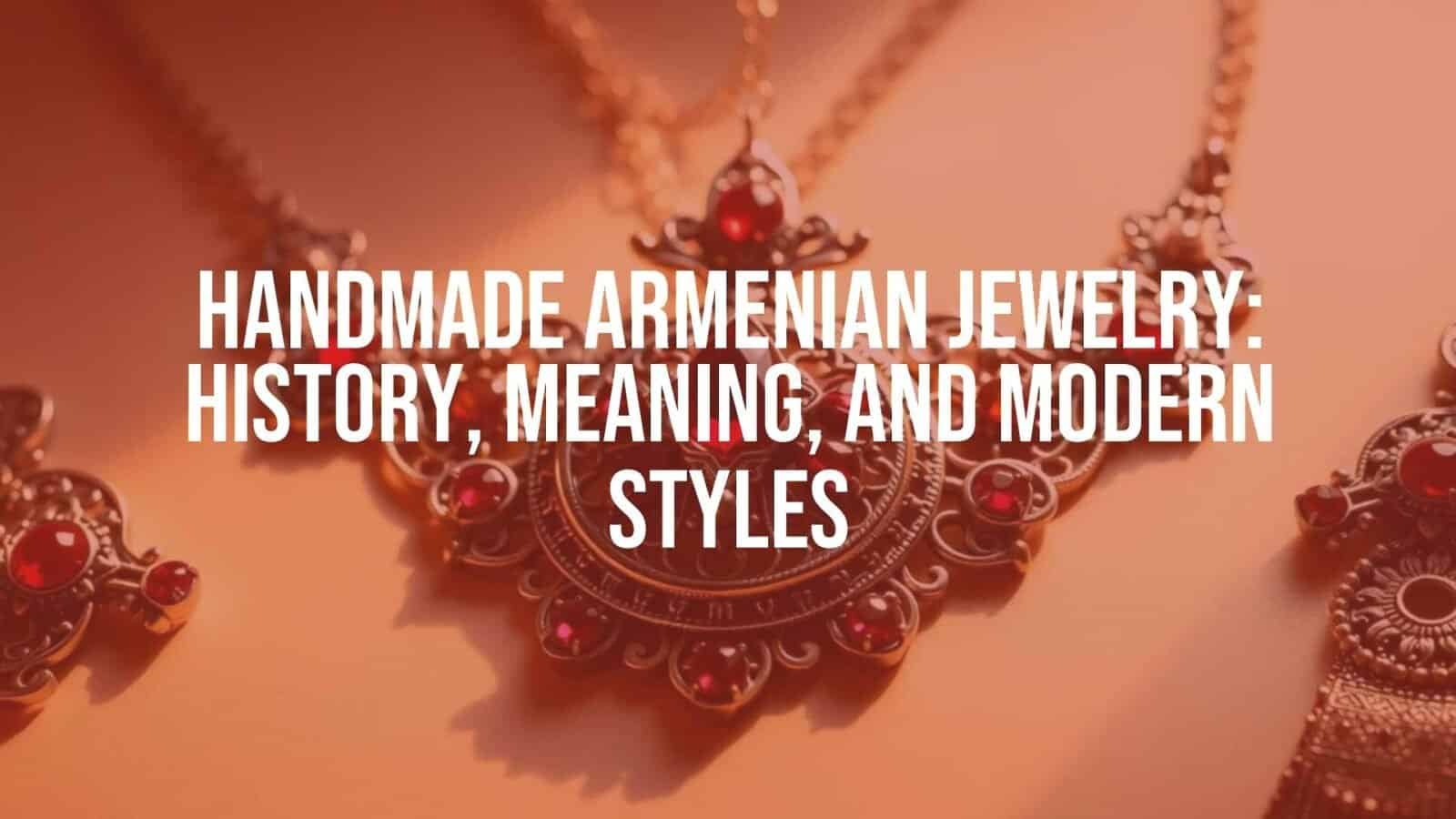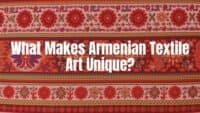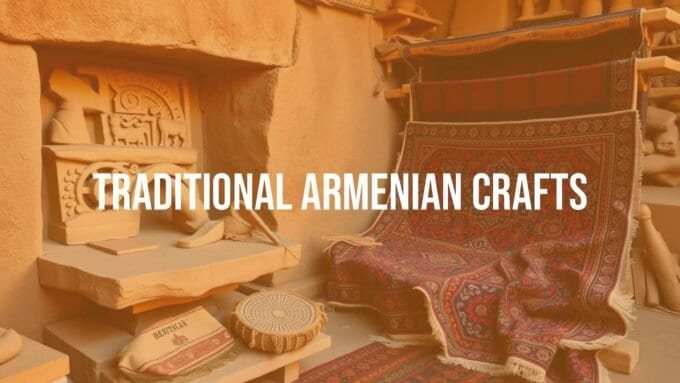Handmade Armenian jewelry is more than decoration. It carries over 3,000 years of history, faith, and artistic skill. Every item, from fine filigree necklaces to pomegranate pendants, shares a story of identity and strength. It reflects Armenia’s love for beauty, mixing ancient traditions with spiritual themes and today’s style. This guide looks at what makes Armenian jewelry special, including its history, styles, craft methods, and place in modern life.
What Defines Handmade Armenian Jewelry?
Handmade Armenian jewelry is not just a way of making things. It is a link to heritage and a promise to preserve old methods. It reflects the maker’s care in every curve of silver or gold and in every chosen stone.
What Qualifies Jewelry as Handmade in Armenia?
True handmade Armenian jewelry is made by artisans using methods passed from one generation to the next. It is not mass-produced. It is a careful, time-consuming process where hands shape, engrave, and assemble each part. Small variations-the slight wave in a filigree line or the touch of an engraver-show the maker’s mark and set it apart from machine-made work. This human touch gives each piece a link to Armenian culture.
Many makers today, including those backed by groups like HDIF, work to keep these skills alive. They help these crafts continue, connecting old techniques with new fans. When you buy handmade Armenian jewelry, you bring home a piece of living craft and cultural memory.
How Are Armenian Jewelry Traditions Reflected in Craftsmanship?
Tradition shapes every step of Armenian jewelry. Makers use fine methods like filigree, where thin wires form lace-like patterns, and repoussé, which raises designs by hammering metal from the back. Engraving adds symbols and fine lines that tell stories. These are not just pretty details. They carry beliefs and ideas in forms that last.

Colors, metals, stones, and motifs show Armenia’s taste and history. Choices in design point to faith, nature, and family symbols. This steady attention to old methods keeps each piece both beautiful and meaningful.
Historic Significance of Armenian Jewelry
Armenian jewelry is like a record you can hold. It links today with a long past, expressing beliefs, art, and identity. It served as decoration and as a sign of safety, fertility, and status.
Which Symbols and Motifs Are Unique to Armenian Design?
Symbols are central in Armenian jewelry. The Armenian cross, or khachkar, appears often in pendants and earrings, pointing to a deep Christian tradition. It stands for life, unity, and protection. The pomegranate is another favorite, showing life, abundance, and national pride. Its shape and seeds work well in jewelry and other crafts.
Ancient signs from the Urartian era, like rosettes (linked to Venus) and eight-point stars (connected with Ishtar), also appear. These early symbols, once tied to the sky and seasons, later blended with Christian themes. The “evil eye,” or achq, is common in necklaces and bracelets to guard against harm. Animal signs like frogs stood for fertility, and sun and moon images suggested balance. Together these motifs tell the layered story of Armenia’s culture and spirit.
| Symbol | Meaning | Common Use |
|---|---|---|
| Khachkar (Armenian cross) | Faith, eternal life, protection | Pendants, earrings, rings |
| Pomegranate | Life, abundance, national identity | Pendants, bracelets, ceramics |
| Evil eye (achq) | Protection from harm | Amulets, necklaces, bracelets |
| Rosette / 8-point star | Astral links, harmony | Pendants, metalwork |
| Frog, sun, moon | Fertility, balance | Men’s pieces, belt decor |

How Has Armenian Jewelry Changed across Centuries?
Jewelry-making in Armenia goes back more than 3,000 years. Early Urartian pieces carried astral signs and had ritual use. With the rise of Christianity, older themes mixed with Christian ones, and the khachkar became central. Finds from Metsamor and Lchashen, with star maps and carvings, show a long path of skilled work.
Over time, artisans refined filigree, repoussé, and engraving, keeping cultural stories alive in metal. The Ottoman era brought regional styles. In recent decades, designers have brought back old motifs in new ways that suit modern taste, reaching a wider public while staying true to roots. This path shows both growth and the resilience of Armenian culture.
What Were the Ancient Protective and Spiritual Meanings?
In old Armenia, jewelry protected the wearer. People believed certain pieces guarded mothers and babies, and jingling elements could scare off spirits. These items were close to daily life and belief.
Jewelry also linked people to the sky, seasons, and blessings for fertility and prosperity. Garnets signaled love and loyalty and were shared as gifts. The evil eye sign pushed away harm, while sun and moon signs brought balance. Each piece was a small guardian and a sign of faith.
Types of Handmade Armenian Jewelry
Handmade Armenian jewelry comes in many forms. Each type carries its own story and shows the depth of local craft.
Traditional Armenian Necklaces and Pendants
Necklaces and pendants often lead the look and carry strong meaning. Khachkars and pomegranates appear often. Many pendants show filigree work in fine silver or gold patterns. Coin-shaped pendants marked events or status in the past. Needlework pieces like the “Sivas/Svaz” and “Marash Double Cross” stitch necklaces join textile art with metal, blending beauty and heritage.
Armenian Bracelets, Bangles, and Cuffs
Bracelets range from simple bands to bold cuffs. Married women often wore rich bracelets, sometimes with almond shapes or seashells to suggest femininity and creation. Repoussé adds raised designs, and engraving adds detail. Silver is common in bracelets for its look and long history in Armenia. These pieces often include signs meant to protect or bring luck.

Significance of Rings in Armenian Heritage
Rings carry personal meaning. They can show marriage, family ties, or faith. Many rings include engraved texts, patterns, or a khachkar. At the Yerevan Gold Market, you can find rings with lines from the 5th-century Armenian Bible, tying belief to craft. Rings often pass down through families as treasured keepsakes.
Earrings and Other Decorative Pieces
Earrings repeat key themes like the Armenian cross and fine filigree. Makers also create hair pins, brooches, and small pins with the same care and symbols. These smaller pieces add layers to an outfit while keeping meaning close.
Men’s Jewelry: History and Modern Styles
Armenian men have long worn jewelry with strong meaning tied to role and rank. Silver belts stood for manhood, and gold marked wealth. Pendants and amulets offered protection and showed links to family and duty. Animal motifs like frogs hinted at fertility, and belt signs pointed to unity and life.
Today, men’s jewelry mixes heritage with clean design. Robert Tateossian, who has Armenian roots, blends engineering ideas with style-think moving gears in cufflinks or patterns inspired by Urartian art and khachkars. These pieces let men show identity with modern polish.
Women’s Jewelry: Innovation and Symbolism
Women’s jewelry in Armenia marks beauty and life stages. Silver belts could suggest fertility, while gold belts signaled marriage and prosperity. Married women wore rich headpieces, bracelets, and necklaces with almond shapes or shells, echoing creation and womanhood. Many pieces carried protective or religious signs.
Today, brands like Pregomesh, started by singer Sirusho, revive designs from Vaspurakan and Cilicia and reshape them for now. Coin pendants and decorative belts reappear with new life. The mix of old meaning and current style keeps women’s jewelry both expressive and wearable.
Role of Protective Amulets and Religious Icons
Amulets and religious icons sit at the center of Armenian jewelry. As the first Christian nation, Armenia weaves faith into art. The khachkar shows up in many forms as a sign of belief, life, and safety. The evil eye charm (achq) and other talismans try to block harm and invite good luck. These pieces blend belief with craft and remain popular across time.
Materials and Techniques in Armenian Jewelry Making
The materials and methods behind handmade Armenian jewelry give it its look and meaning. Old skills and careful choices create pieces that tell stories.
Traditional Metals and Stones Used
Gold and silver are the main metals. Gold signaled wealth and often appeared in pieces for the upper class. Silver saw wider use and held special meaning, especially in men’s belts. Metal choice shaped style and value.
Garnets were beloved stones, standing for love and loyalty, and were common gifts. Makers also used local stones. The focus often rested on the natural beauty of the metalwork and stone, not only on rare gems.
| Material | Use and Notes |
|---|---|
| Gold | Symbol of status; used in ornate pieces |
| Silver | Wide use; strong tie to belts and bracelets |
| Garnet | Love and loyalty; common in gifts |
| Local stones | Nature-inspired; chosen for beauty and fit |
Distinctive Methods: Filigree, Engraving, and Enamel
Armenian makers excel at fine methods. Filigree twists thin wires into lace-like shapes and needs great patience and precision. The result is both strong and light. Repoussé raises forms from the back of the metal, adding depth.

Engraving cuts lines and words into metal, often with symbols or verses. Enamel, common in places like Gyumri, adds bright color with a smooth glass finish. These methods form a language through which Armenian jewelry shares its past and values.
Contemporary Adaptations and Ethical Sourcing
Today’s makers blend old methods with new looks. They rework ancient motifs for modern style while keeping an Armenian feel. They try new shapes and material mixes, widening what a piece can be.
Many designers also focus on recycled metals and responsibly sourced stones, matching global eco-minded trends. This way, the craft stays meaningful while meeting modern standards for responsible production.
Modern Interpretations and Trends
Modern Armenian jewelry brings old and new together. Makers keep the voice of the past while shaping fresh designs that speak to people everywhere.
Blending Heritage with Contemporary Aesthetics
Designers today weave historic themes like khachkars and pomegranates into clean, minimal forms or bold, artistic shapes. This balance respects tradition without getting stuck in it. It reflects Armenia’s lasting love for ornament and its place in today’s fashion.
Silver work has grown again, with artisans mixing classic patterns with modern lines. This approach helps the symbols and fine craft reach more people who enjoy both history and current style.
Influential Armenian Jewelry Designers
Sirusho launched Pregomesh in 2012, bringing music, culture, and fashion together. Her team studies historic designs from the Armenian Highlands and revives styles from Vaspurakan and Cilicia, like coin pendants and belts, working with anthropologists and museum sources.
Arman Nur’s Nur Art Gallery explores wearable art with bronze, sterling silver, and recycled metals. His kinetic jewelry moves and shifts shape on the body, adding motion to design. Robert Tateossian, an Armenian-Lebanese designer in London, is known for merging engineering with style. His pieces, worn by leaders worldwide, often draw on Urartian art and khachkars, bringing Armenian ideas to a luxury market.
How Does Modern Armenian Jewelry Appeal to Global Audiences?
People around the world value meaning and story. Armenian jewelry offers both, with skilled work and symbols like khachkars and pomegranates that give depth beyond factory-made items.
Also, many designers use recycled metals and responsibly sourced stones, which speaks to eco-aware buyers. Old motifs in modern forms fit many looks, from classic to bold. Designers like Robert Tateossian raise the profile of Armenian craft by showing it on global stages.
Museums and Cultural Hubs Showcasing Armenian Jewelry
To fully appreciate Armenian jewelry, visit the places that care for and display it. These museums and centers connect visitors with the country’s artistic roots.
Renowned Museums Featuring Historic Armenian Pieces
The Armenian Ethnography Museum of Sardarapat in Armavir shows traditional jewelry worn by warriors and women. Silver belts, detailed earrings, and necklaces highlight how jewelry shaped daily and ceremonial life.
The Metsamor Historical-Archaeological Museum-Reserve in Metsamor holds finds from the Bronze Age. Gold and bronze pieces reveal early makers’ high skill and give a window into the start of Armenian jewelry.
In central Yerevan, the History Museum of Armenia presents gold jewelry from the 11th-13th centuries. These items help trace how styles and methods changed over time. Together, these museums offer a broad view of Armenia’s jewelry story.
| Museum | Location | Highlights |
|---|---|---|
| Armenian Ethnography Museum of Sardarapat | Armavir | Traditional belts, earrings, and ceremonial pieces |
| Metsamor Historical-Archaeological Museum-Reserve | Metsamor | Bronze Age gold/bronze jewelry; early techniques |
| History Museum of Armenia | Yerevan | Gold jewelry from 11th-13th centuries; style changes |
Cultural Centers Preserving Jewelry Heritage
Beyond museums, cultural centers and galleries keep the craft active. They host workshops, teach skills, and show new work. The Nur Art Gallery, led by Arman Nur, serves as both studio and gallery, where visitors can see works in progress and meet artists.
These places help pass on methods and symbols in fresh ways. They give space to both known and new makers, share knowledge with the public, and keep the story of Armenian jewelry growing.
Where to Buy Handmade Armenian Jewelry in Armenia
If you want to take home a piece of this heritage, Armenia offers many places to find authentic handmade jewelry-from open-air markets to design studios and gold markets.
Yerevan’s Vernissage Market: Artisans and Finds
The Vernissage open-air market near Republic Square is a must-see for handmade jewelry and local craft. Spanning several blocks, it shines with traditional pieces made with repoussé and filigree.

Vendors sell rings, earrings, and necklaces inspired by medieval manuscripts and religious art, including styles like those linked to the 9th-century Tatev Monastery. You will also find carpets, wood art, embroidery, ceramic pomegranates, and Soviet-era items. Watch artists paint or carve, and look for symbols like the eternity sign or Mount Ararat. Vernissage draws locals and visitors and plays an important role in keeping folk arts alive. Best time: weekends, 10:00 AM-5:00 PM, at Aram Street and Buzand Street, Yerevan 0010.
Popular Studios and Boutiques (Pregomesh, Nur Art Gallery, Tateossian)
Pregomesh (Northern Ave 11/1, daily 11:00 AM-09:00 PM), founded by Sirusho, brings back designs from Vaspurakan and Cilicia based on deep research, with coin pendants and belts informed by museum sources.
The Nur Art Gallery (1 Amiryan Street, Tue-Sun 12:00 PM-7:00 PM) is a working studio for experimental design. Arman Nur blends metalwork with personal themes and uses bronze, sterling silver, and recycled metals to make kinetic jewelry that moves when worn.
Tateossian, created by Robert Tateossian in London, keeps ties to Armenian heritage. His refined collections, sometimes inspired by Urartian art and khachkars, are worn by leaders worldwide. Yerevan store: 50 Mesrop Mashtots Ave, daily 11:00 AM-8:00 PM.
Yerevan Gold Market and Regional Shopping Tips
The Yerevan Gold Market is the main center for gold and custom work. Find it at 16 Khorenatsi Street, near Tigran Mets Avenue (Yerevan 0010). Inside are 100+ booths, many run by families whose skills go back generations, including descendants of jewelers who survived the Armenian Genocide. You can find pieces with strong religious themes, like rings engraved with lines from the 5th-century Armenian Bible. Many booths accept custom orders, from personal amulets to church items used by the Armenian Apostolic Church. Hours: daily 10:00 AM-6:00 PM.
Beyond Yerevan, Gyumri is known for fine filigree and enamel, keeping 19th-century methods alive. Dilijan offers nature-themed jewelry using local stones. Echmiadzin sells religious items, khachkar replicas, and jewelry linked to its spiritual life. For authentic finds, seek local artisans and small shops, especially near churches and monasteries.
How to Recognize Authentic Handmade Pieces
- Look for small irregularities. Perfect symmetry can point to machine work.
- Check details in filigree, repoussé, and engraving. Handwork has depth and texture.
- Review materials. Silver and gold are common; garnets and local stones appear often.
- Ask about the maker and process. Good sellers share stories and methods.
- Buy from trusted places like Vernissage, Pregomesh, or Nur Art Gallery.
- Trust your eye. Handmade pieces often feel alive and personal.
Choosing Handmade Armenian Jewelry as a Gift
Giving handmade Armenian jewelry shares beauty, history, and meaning with someone you care about. It is a lasting and thoughtful gift.
Best Gift Ideas Symbolizing Armenian Heritage
- Khachkar pendants: small cross-stone designs that signal faith, unity, and protection.
- Pomegranate pieces: pendants, earrings, or bracelets that stand for life and abundance.
- Filigree or enamel items: show fine skill and color, rooted in long-held methods.
- Textile-inspired jewelry: designs that echo lace (agtagorts) or woven belts (gordz) in wearable form.
Pick items that connect with the person’s taste while celebrating Armenia’s spirit.
Selecting Meaningful Pieces for Men and Women
Match the piece to the person, while keeping the cultural meaning.
- For women: necklaces with almond shapes or shells, bracelets with protective signs, earrings with crosses or pomegranates. Choose delicate filigree for a soft look or bright enamel for a bolder style.
- For men: silver belts for a standout gift, pendants or amulets with warrior or family themes, or cufflinks with subtle khachkar lines. Urartian-inspired shapes add a historic touch with modern polish.
Pieces that carry a story-through symbols or craft-become keepsakes.
Experiencing Armenian Jewelry through Travel and Tours
You can go beyond buying by visiting places where jewelry is made and learning how it fits into daily life and belief.
Visiting Jewelry Workshops on Cultural Tours
Many tours now stop at studios where you can watch artisans at work. See a maker carefully twist silver wires into filigree or engrave a pendant with a meaningful sign. These visits build respect for the patience and skill behind each piece.
Talking with artisans, hearing their paths, and seeing old methods in use turns a purchase into a personal connection with the craft.
Jewelry-Focused Pilgrimages and Heritage Itineraries
Special trips can link churches and monasteries with archaeological sites like Metsamor to show how jewelry took shape over time. You might view gold pieces at the History Museum of Armenia, then walk Vernissage to see how those themes live on today.
These routes offer a fuller view of how jewelry reflects Armenia’s faith, strength, and art across many centuries.
Tips for Caring for and Wearing Handmade Armenian Jewelry
With the right care, handmade Armenian jewelry will keep its look and meaning for years. Simple habits help a lot.
Cleaning and Maintenance for Longevity
- After wearing silver, wipe it with a soft cloth to remove oils and dirt.
- For a deeper clean, use mild soap and warm water with a soft brush; rinse and dry well to reduce tarnish.
- Use a silver polishing cloth for tarnish, but avoid harsh chemicals, especially on stones or enamel.
- Clean gold with mild soap and water; check stone settings now and then.
- Store pieces in separate pouches or slots to avoid scratches and tangles; keep them cool, dry, and out of direct sun.
Styling Handmade Armenian Pieces for Modern Outfits
For a subtle touch, pair a small filigree pendant or khachkar earring with a simple, modern outfit. The contrast highlights the fine work. For a bolder look, wear a large pomegranate necklace or a detailed repoussé cuff with a plain dress or blazer to let the piece stand out. Mix old and new-an Armenian ring can sit next to modern bands. Let the jewelry speak with its symbols and history, whether for a casual day or a formal night.














Leave a comment